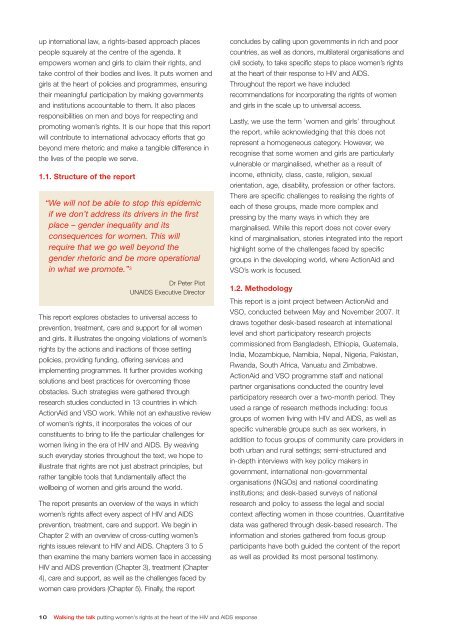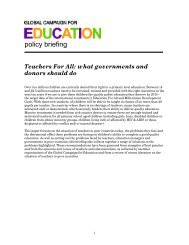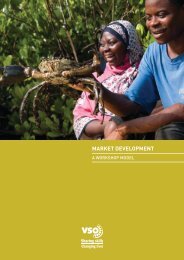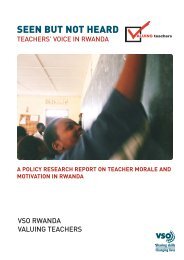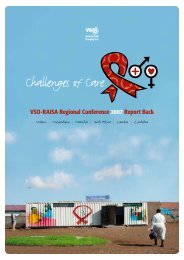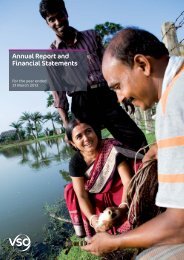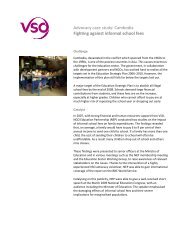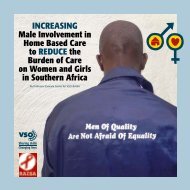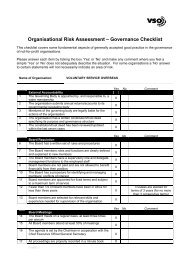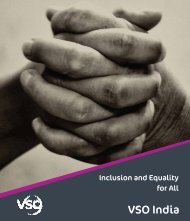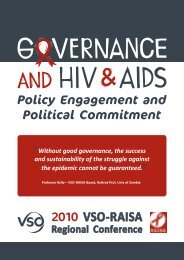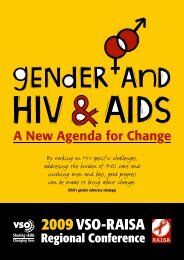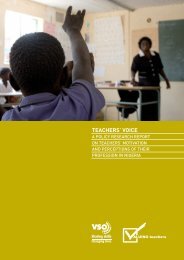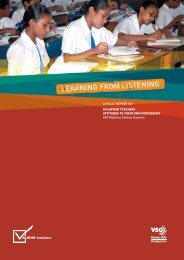Walking the Talk - VSO
Walking the Talk - VSO
Walking the Talk - VSO
Create successful ePaper yourself
Turn your PDF publications into a flip-book with our unique Google optimized e-Paper software.
up international law, a rights-based approach placespeople squarely at <strong>the</strong> centre of <strong>the</strong> agenda. Itempowers women and girls to claim <strong>the</strong>ir rights, andtake control of <strong>the</strong>ir bodies and lives. It puts women andgirls at <strong>the</strong> heart of policies and programmes, ensuring<strong>the</strong>ir meaningful participation by making governmentsand institutions accountable to <strong>the</strong>m. It also placesresponsibilities on men and boys for respecting andpromoting women’s rights. It is our hope that this reportwill contribute to international advocacy efforts that gobeyond mere rhetoric and make a tangible difference in<strong>the</strong> lives of <strong>the</strong> people we serve.1.1. Structure of <strong>the</strong> report“We will not be able to stop this epidemicif we don’t address its drivers in <strong>the</strong> firstplace – gender inequality and itsconsequences for women. This willrequire that we go well beyond <strong>the</strong>gender rhetoric and be more operationalin what we promote.” 3Dr Peter PiotUNAIDS Executive DirectorThis report explores obstacles to universal access toprevention, treatment, care and support for all womenand girls. It illustrates <strong>the</strong> ongoing violations of women’srights by <strong>the</strong> actions and inactions of those settingpolicies, providing funding, offering services andimplementing programmes. It fur<strong>the</strong>r provides workingsolutions and best practices for overcoming thoseobstacles. Such strategies were ga<strong>the</strong>red throughresearch studies conducted in 13 countries in whichActionAid and <strong>VSO</strong> work. While not an exhaustive reviewof women’s rights, it incorporates <strong>the</strong> voices of ourconstituents to bring to life <strong>the</strong> particular challenges forwomen living in <strong>the</strong> era of HIV and AIDS. By weavingsuch everyday stories throughout <strong>the</strong> text, we hope toillustrate that rights are not just abstract principles, butra<strong>the</strong>r tangible tools that fundamentally affect <strong>the</strong>wellbeing of women and girls around <strong>the</strong> world.The report presents an overview of <strong>the</strong> ways in whichwomen’s rights affect every aspect of HIV and AIDSprevention, treatment, care and support. We begin inChapter 2 with an overview of cross-cutting women’srights issues relevant to HIV and AIDS. Chapters 3 to 5<strong>the</strong>n examine <strong>the</strong> many barriers women face in accessingHIV and AIDS prevention (Chapter 3), treatment (Chapter4), care and support, as well as <strong>the</strong> challenges faced bywomen care providers (Chapter 5). Finally, <strong>the</strong> reportconcludes by calling upon governments in rich and poorcountries, as well as donors, multilateral organisations andcivil society, to take specific steps to place women’s rightsat <strong>the</strong> heart of <strong>the</strong>ir response to HIV and AIDS.Throughout <strong>the</strong> report we have includedrecommendations for incorporating <strong>the</strong> rights of womenand girls in <strong>the</strong> scale up to universal access.Lastly, we use <strong>the</strong> term ’women and girls’ throughout<strong>the</strong> report, while acknowledging that this does notrepresent a homogeneous category. However, werecognise that some women and girls are particularlyvulnerable or marginalised, whe<strong>the</strong>r as a result ofincome, ethnicity, class, caste, religion, sexualorientation, age, disability, profession or o<strong>the</strong>r factors.There are specific challenges to realising <strong>the</strong> rights ofeach of <strong>the</strong>se groups, made more complex andpressing by <strong>the</strong> many ways in which <strong>the</strong>y aremarginalised. While this report does not cover everykind of marginalisation, stories integrated into <strong>the</strong> reporthighlight some of <strong>the</strong> challenges faced by specificgroups in <strong>the</strong> developing world, where ActionAid and<strong>VSO</strong>’s work is focused.1.2. MethodologyThis report is a joint project between ActionAid and<strong>VSO</strong>, conducted between May and November 2007. Itdraws toge<strong>the</strong>r desk-based research at internationallevel and short participatory research projectscommissioned from Bangladesh, Ethiopia, Guatemala,India, Mozambique, Namibia, Nepal, Nigeria, Pakistan,Rwanda, South Africa, Vanuatu and Zimbabwe.ActionAid and <strong>VSO</strong> programme staff and nationalpartner organisations conducted <strong>the</strong> country levelparticipatory research over a two-month period. Theyused a range of research methods including: focusgroups of women living with HIV and AIDS, as well asspecific vulnerable groups such as sex workers, inaddition to focus groups of community care providers inboth urban and rural settings; semi-structured andin-depth interviews with key policy makers ingovernment, international non-governmentalorganisations (INGOs) and national coordinatinginstitutions; and desk-based surveys of nationalresearch and policy to assess <strong>the</strong> legal and socialcontext affecting women in those countries. Quantitativedata was ga<strong>the</strong>red through desk-based research. Theinformation and stories ga<strong>the</strong>red from focus groupparticipants have both guided <strong>the</strong> content of <strong>the</strong> reportas well as provided its most personal testimony.10 <strong>Walking</strong> <strong>the</strong> talk putting women's rights at <strong>the</strong> heart of <strong>the</strong> HIV and AIDS response


